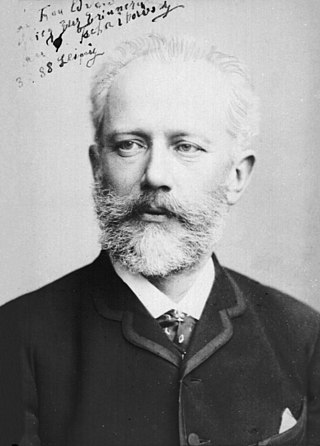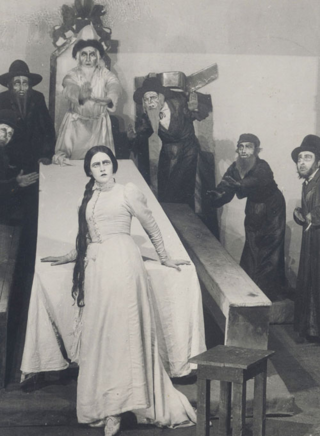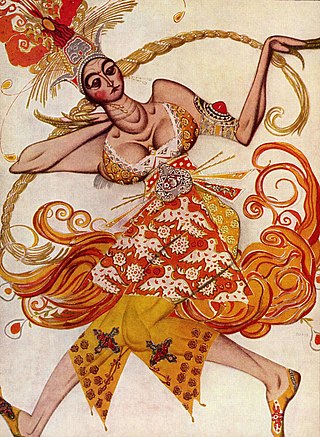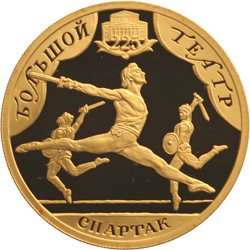
The Nutcracker, Op. 71, is an 1892 two-act classical ballet by Pyotr Ilyich Tchaikovsky, set on Christmas Eve at the foot of a Christmas tree in a child's imagination featuring a Nutcracker doll. The plot is an adaptation of Alexandre Dumas' 1844 short story The Nutcracker, itself a retelling of E. T. A. Hoffmann's 1816 short story The Nutcracker and the Mouse King. The ballet's first choreographer was Marius Petipa, with whom Tchaikovsky had worked three years earlier on The Sleeping Beauty, assisted by Lev Ivanov. Although the complete and staged The Nutcracker ballet was not initially as successful as the 20-minute Nutcracker Suite that Tchaikovsky had premiered nine months earlier, it became popular in later years.

New York City Ballet (NYCB) is a ballet company founded in 1948 by choreographer George Balanchine and Lincoln Kirstein. Balanchine and Jerome Robbins are considered the founding choreographers of the company. Léon Barzin was the company's first music director. City Ballet grew out of earlier troupes: the Producing Company of the School of American Ballet, 1934; the American Ballet, 1935, and Ballet Caravan, 1936, which merged into American Ballet Caravan, 1941; and directly from the Ballet Society, 1946.

The Dybbuk, or Between Two Worlds is a play by S. An-sky, authored between 1913 and 1916. It was originally written in Russian and later translated into Yiddish by An-sky himself. The Dybbuk had its world premiere in that language, performed by the Vilna Troupe at Warsaw in 1920. A Hebrew version was prepared by Hayim Nahman Bialik and staged in Moscow at Habima Theater in 1922.

Neoclassical ballet is the style of 20th-century classical ballet exemplified by the works of George Balanchine. The term "neoclassical ballet" appears in the 1920s with Sergei Diaghilev's Ballets Russes, in response to the excesses of romanticism and post-romantic modernism. It draws on the advanced technique of 19th-century Russian Imperial dance, but strips it of its detailed narrative and heavy theatrical setting while retaining many key techniques, such as pointe technique.

Les Sylphides is a short, non-narrative ballet blanc to piano music by Frédéric Chopin, selected and orchestrated by Alexander Glazunov.

The Firebird is a ballet and orchestral concert work by the Russian composer Igor Stravinsky. It was written for the 1910 Paris season of Sergei Diaghilev's Ballets Russes company; the original choreography was by Michel Fokine, who collaborated with Alexandre Benois and others on a scenario based on the Russian fairy tales of the Firebird and the blessing and curse it possesses for its owner. It was first performed at the Opéra de Paris on 25 June 1910 and was an immediate success, catapulting Stravinsky to international fame and leading to future Diaghilev–Stravinsky collaborations including Petrushka (1911) and The Rite of Spring (1913).

Romeo and Juliet, Op. 64, is a ballet by Sergei Prokofiev based on William Shakespeare's play Romeo and Juliet. First composed in 1935, it was substantially revised for its Soviet premiere in early 1940. Prokofiev made from the ballet three orchestral suites and a suite for solo piano.

Appalachian Spring is an American ballet created by the choreographer Martha Graham and the composer Aaron Copland, later arranged as an orchestral work. Commissioned by Elizabeth Sprague Coolidge, Copland composed the ballet music for Graham; the original choreography was by Graham, with costumes by Edythe Gilfond and sets by Isamu Noguchi. The ballet was well received at the 1944 premiere, earning Copland the Pulitzer Prize for Music during its 1945 United States tour. The orchestral suite composed in 1945 was played that year by many symphony orchestras; the suite is among Copland's best-known works, and the ballet remains essential in the Martha Graham Dance Company repertoire.

Spartacus is a ballet by Aram Khachaturian (1903–1978). The work follows the exploits of Spartacus, the leader of the slave uprising against the Romans known as the Third Servile War, although the ballet's storyline takes considerable liberties with the historical record. Khachaturian composed Spartacus in 1954, and was awarded a Lenin Prize for the composition that same year. It was first staged in Leningrad on 27 December 1956, as choreographed by Leonid Yakobson, for the Kirov Theatre of Opera and Ballet, where it stayed in repertory for many years, but only with qualified success since Yakobson abandoned conventional pointe in his choreography. Yakobson restaged his version for the Bolshoi in 1962 and it was part of the Bolshoi's 1962 tour to New York. The ballet received its first staging at the Bolshoi Theatre, Moscow in 1958, choreographed by Igor Moiseyev; however it was the 1968 production, choreographed by Yury Grigorovich, which achieved the greatest acclaim for the ballet.
Dance suite may refer to the form of the musical suite known as the suite de danses.
Eliot Feld is an American modern ballet choreographer, performer, teacher, and director. Feld works in contemporary ballet. His company and schools, including the Feld Ballet and Ballet Tech, are involved in dance and dance education in New York City.
Le Baiser de la fée is a neoclassical ballet in one act and four scenes composed by Igor Stravinsky in 1928 and revised in 1950 for George Balanchine and the New York City Ballet. Based on Hans Christian Andersen's short story Isjomfruen, the work is an homage to Pyotr Ilyich Tchaikovsky, for the 35th anniversary of the composer's death. Stravinsky elaborated several melodies from early piano pieces and songs by Tchaikovsky in his score. A commission by Ida Rubinstein from 1927, the ballet was choreographed by Bronislava Nijinska and premiered in Paris on 27 November 1928.

Sophie Maslow was an American choreographer, modern dancer and teacher, and founding member of New Dance Group. She was a first cousin of the American sculptor Leonard Baskin.
Medea's Dance of Vengeance is a composition by the American composer Samuel Barber, derived from his earlier ballet suite Medea and loosely based on the play Medea by Euripides. Barber first created a seven-movement concert suite from this ballet, and five years later reduced this concert suite down to a single-movement concert piece using what he felt to be the strongest portions of the work. He originally titled it Medea's Meditation and Dance of Vengeance, but shortly before his death, he changed the title to simply Medea's Dance of Vengeance.
Ofer Ben-Amots is an Israeli-American composer and teacher of music composition and theory at Colorado College. His music is inspired by Jewish folklore of Eastern-European Yiddish and Judeo-Spanish Ladino traditions. The interweaving of folk elements with contemporary textures creates the dynamic tension that permeates and defines Ben-Amots' musical language.
West Side Story Suite is a ballet suite choreographed by Jerome Robbins. Robbins conceived, directed and choreographed the 1957 musical West Side Story, then co-directed its 1961 film adaptation, before including parts of the choreography in the anthology Jerome Robbins' Broadway. Robbins developed the latter to the ballet West Side Story Suite for the New York City Ballet, which premiered on May 18, 1995, at the New York State Theater.
Dybbuk is a ballet made by New York City Ballet ballet master Jerome Robbins to Leonard Bernstein's eponymous music and taking S. Ansky's play The Dybbuk as a source. The premiere took place on 16 May 1974, at New York State Theater, Lincoln Center, with scenery by Rouben Ter-Arutunian, costumes by Patricia Zipprodt and lighting by Jennifer Tipton. A revision of the choreography and the score was made later the same year; the ballet was renamed Dybbuk Variations and received its own premiere in November.
A Suite of Dances is a ballet choreographed by Jerome Robbins to Johann Sebastian Bach's Cello Suites. The ballet was created for Mikhail Baryshnikov and premiered on March 3, 1994, at the New York State Theater.
Maria Calegari is an American ballet dancer, teacher and répétiteur. She joined the New York City Ballet in 1974 and became a principal dancer in 1983. She left the company in 1994, then occasionally performed until 2004. She also teaches ballet and began working as a répétiteur for the Balanchine Trust and Robbins Rights Trust in 1996 and 2003 respectively.









